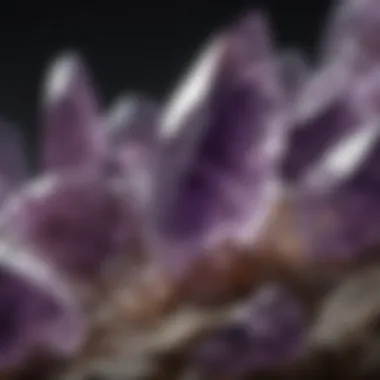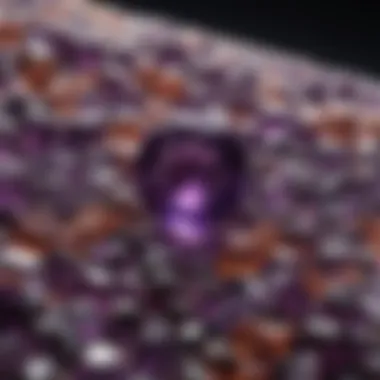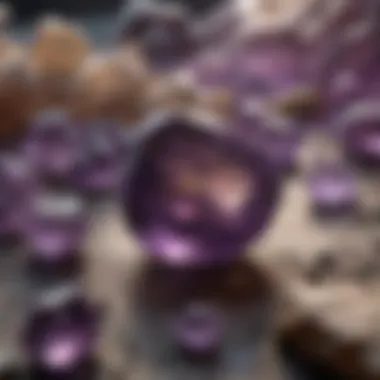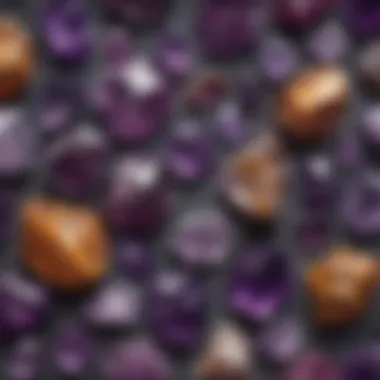Understanding the Value of Raw Amethyst


Intro
Understanding the value of raw amethyst involves knowing various factors that contribute to its worth. Amethyst, a purple variety of quartz, garners interest not only for its aesthetic appeal but also for its geological significance. This article aims to dissect the elements that influence its value, including quality characteristics, market trends, sources, and pricing fluctuations.
The significance of raw amethyst extends beyond mere decoration; it encompasses geological, historical, and even metaphysical aspects. As we delve into this realm, we will demystify the valuation process applicable to collectors, students, and enthusiasts alike. A thorough appreciation of these components enables one to make informed decisions in purchasing, trading, or simply valuing amethyst specimens.
Rock and Fossil Identification
When evaluating raw amethyst, it is crucial to identify the specific characteristics that distinguish it from other minerals. The identification process focuses on several key elements, including color, clarity, and the presence of any inclusions. Collectors should also familiarize themselves with the types of amethyst available in the market.
Types of Amethyst
- Brazilian Amethyst: Highly sought after for its deep color and clarity.
- Uruguayan Amethyst: Known for its rich hues and larger crystals, often considered the finest.
- Zambia Amethyst: Features a more intense purple color but less clarity compared to Brazilian.
Characteristics to Look For
To ascertain the worth of any raw amethyst, collectors should pay attention to:
- Color Saturation: Deep purple shades generally command higher prices.
- Clarity: Fewer inclusions or flaws lead to increased desirability.
- Crystal Formation: Well-formed crystals are more valuable than irregular shapes.
Tools for Identification
Accurate identification of raw amethyst requires certain tools:
- Hand Lens or Loupe: For close inspection of clarity and inclusions.
- Color Chart: To compare shades and ensure accurate assessments.
- Scale: To weigh specimens for proper pricing evaluation.
Collecting Tips and Techniques
Collecting raw amethyst can be rewarding, but it requires knowledge and technique. Best practices can enhance both the enjoyment and the yield of your collection efforts.
Best Practices for Collecting
- Research Locations: Know where high-quality finds are likely.
- Understand Local Regulations: Ensure compliance with any collecting laws.
- Be Respectful of Nature: Follow best environmental practices when collecting.
Locating Prime Collecting Sites
Amethyst can often be found in:
- Geodes and Vugs: Natural cavities in rock formations.
- Mining Sites: Places like the Amethyst Mine Panorama in Ontario offer opportunities for collection.
How to Safely Extract Specimens
Care should be taken during extraction. Using proper tools, such as:
- Pickaxe: For breaking rock away from geodes.
- Hammer and Chisel: For more precise removal without damage.
Preservation and Display
Proper preservation is essential to maintaining the value and beauty of raw amethyst. Keeping collections safe requires attention to storage and display methods.
Techniques for Preserving Rocks and Fossils
- Humidity Control: Store in a dry environment to prevent mold.
- Avoid Direct Sunlight: UV rays can fade colors over time.
Proper Storage Methods
Store raw amethyst in:
- Cotton Bags: To avoid scratches during storage.
- Acid-Free Boxes: Ensure the long-term safety of your specimens.
Creative Display Ideas
Displaying your collection can enhance appreciation. Consider:
- Shadow Boxes: To create depth.
- Simple Shelves: For an elegant presentation.
Geological Insights


Understanding the geological background of amethyst adds another layer of appreciation. Knowledge of its origins can influence perceived worth and significance among collectors.
Geological Formations and Processes
Amethyst forms in volcanic rocks and hydrothermal veins, often in geodes. Studying these processes provides insight into the rarity and formation conditions of various specimens.
Historical Significance
Historically, amethyst has been valued since ancient civilizations. Its use in jewelry and decoration speaks to its cultural importance.
Notable Discoveries in the Field
Several significant amethyst discoveries have impacted its valuation, including:
- Discovery of Large Brazilian Amethyst Geodes: In the 20th century, these finds shifted market dynamics.
Understanding these aspects not only enriches your knowledge but also allows for deeper appreciation of raw amethyst and its worth.
Understanding Raw Amethyst
Understanding raw amethyst is essential for anyone involved in gemology or geology. It is the foundation upon which value is assessed, and it provides the context necessary for informed purchasing or selling decisions. Without a firm grasp of what raw amethyst truly is, collectors may miss critical nuances that influence its worth, both in aesthetic appeal and market value.
Definition of Raw Amethyst
Raw amethyst refers to uncut and unpolished pieces of the amethyst mineral, which is a purple variety of quartz. Unlike polished gemstones often seen in jewelry, raw amethyst retains its natural form and features. This can include rough, crystal clusters or singular pieces, showcasing their original geological characteristics. The natural state of raw amethyst can exhibit color gradients, growth lines, and even inclusions, contributing to its uniqueness and potential value.
Formation Process
The formation of amethyst involves a complex geological process that requires specific conditions. Amethyst originates from volcanic activity. It is formed from quartz that crystallizes in cavities within volcanic rocks. Over thousands of years, the presence of iron impurities in the quartz during its formation gives amethyst its characteristic purple hue. The deeper the color, the more desirable the crystal tends to be.
Important Note: Knowledge of the formation process can greatly enhance one’s understanding of the market for raw amethyst, highlighting how its geological history contributes to its valuation.
As collectors and enthusiasts begin to evaluate raw amethyst, understanding these fundamental aspects provides a clearer lens through which to assess its worth. Familiarity with both its definition and formation process opens pathways to deeper insights when examining factors such as color quality, clarity, and market trends.
Factors Affecting Amethyst Value
Understanding the elements influencing the value of raw amethyst is essential for anyone engaged in collecting or studying gemstones. Amethyst is prized for its beauty and metaphysical properties, but these factors can significantly affect its market worth. When evaluating amethyst, collectors must pay attention to several key attributes that can elevate or diminish its value in the eyes of buyers and sellers alike.
Color Quality
The color of amethyst is one of the most critical factors in determining its value. The most sought-after amethyst exhibits a deep, rich purple hue, characterized by a saturation that is neither too dark nor too light. This balance is crucial, as overly dark stones may obscure transparency while excessively light stones may lack vibrancy. The specific hues that can affect value include:
- Deep purple: Most desirable and generally commands the highest prices.
- Medium purple: Still valuable, but may not reach the same price points.
- Light purple: Often viewed as less desirable.
Variations in color within a single specimen can also impact its worth. Stones displaying color zoning, where different shades are visible, can intrigue collectors but also create confusion regarding value. Thus, understanding color intensity and uniformity is vital for appraising raw amethyst.
Clarity and Inclusion
Clarity is another essential aspect of amethyst valuation. A clear stone without visible inclusions is often more valuable than one with noticeable flaws. Inclusions can range from tiny gas bubbles, other crystal fragments, or even liquid inclusions, all of which can detract from a stone's aesthetic appeal. In terms of grades, clarity can fall into the following categories:
- Transparent: Free from inclusions; highest value.
- Translucent: Some inclusions present, noticeable but not overwhelming; moderate value.
- Opaque: Many inclusions or unclear; lowest value.
However, certain inclusions can occasionally enhance a stone's character, resulting in a unique piece that might appeal to specific collectors. This aspect stresses the need for a nuanced understanding of how clarity influences perception and valuation in various contexts.
Size and Weight
The dimensions and weight of raw amethyst directly correlate to its value. Larger specimens tend to be more coveted, as they are rarer in nature. Specifically, the weight of amethyst is measured in carats, with larger carats generally yielding higher prices due to the increased rarity:
- Small (0-5 carats): Commonly available, thus lower in value.
- Medium (5-10 carats): More valuable but not exceptionally rare.
- Large (over 10 carats): Considered rare and commands much higher prices.
In addition to weight, overall size can influence the stone's usability in jewelry or display, making larger, more visually impressive pieces appealing for collectors and jewelers.
Cut and Shape
Finally, the cut and shape of raw amethyst have implications for its overall value. The way a gemstone is cut affects its light performance and visual appeal. Several cuts are common in the market:
- Emerald cut: Highlighting the stone's color and clarity.
- Round cut: Allowing for maximum brilliance, popular in jewelry.
- Cabochon: A flat-bottomed shape displaying color richness, often used for collectors.
The quality of the cut also matters; well-executed cuts enhance brilliance and give depth to the stone. An improperly cut stone can appear dull, inviting a decreased value. Therefore, when evaluating raw amethyst, taking into account the cut and its relationship with light reflection should not be overlooked.


"The interplay of color, clarity, size, and cut creates a complex profile that defines the worth of raw amethyst."
Market Trends and Demand
The evaluation of raw amethyst involves not only its physical characteristics but also an understanding of market trends and demand. Knowledge of current and historical pricing guides both collectors and investors in making informed decisions. Additionally, the fluctuating demand gives insights into how broader economic factors impact this niche market. Recognizing the trends helps in assessing the potential value of amethyst in the future.
Current Market Prices
Currently, the price of raw amethyst varies significantly depending on quality and size. On average, prices may range from $2 to $10 per carat for lower grades, while top-quality specimens can command prices of $50 or more per carat. This fluctuation can occur due to several factors. Notable events such as changes in mining output or shifts in consumer interest can cause immediate effects on pricing.
Furthermore, platforms like eBay and specialized gem auction sites provide real-time insights into current prices. Collectors should regularly check these sources to stay updated on market dynamics. In recent years, online sales have grown, expanding access for both buyers and sellers. This has contributed to some price gains for high-quality specimens, especially among serious collectors.
Historical Price Trends
Looking at historical price trends, one can observe that the market for raw amethyst has seen both stability and periods of volatility. A decade ago, prices for amethyst experienced a downturn largely due to overproduction from large Brazilian mines. However, more recent years have shown a recovery, with increasing interest from collectors and designers.
As per various gemological reports, the historical data indicates that improved quality and branding of Amethyst products have elevated their value. The introduction of high-grade amethysts from places like Uruguay shifted perceptions, impacting overall demand. Tracking these trends over time is essential for anyone regarding raw amethyst as an investment.
Future Predictions of Amethyst Value
Predicting the future value of raw amethyst requires an understanding of market trends as well as socio-economic factors. Analysts suggest that as the vintage jewelry market continues to grow, so will the value of amethyst. Demand from younger collectors who value unique and natural stones is also on the rise. This segment typically seeks distinctive pieces for both personal interest and investment potential.
Overall, addressing market trends and demand is invaluable for both active collectors and new entrants interested in raw amethyst.
Geographical Sourcing of Raw Amethyst
Understanding the geographical sourcing of raw amethyst is crucial for several reasons. It is about more than just knowing where to find these stones; the origins can deeply influence their market value, quality, and even their desirability among collectors. Each region contributes unique characteristics to its amethyst, including color saturation, clarity, and energy levels attributed to the specific environments in which they form.
Major Sources of Amethyst
There are several key areas worldwide recognized for their high-quality amethyst. Notable sources include:
- Brazil: The largest producer, Brazilian amethyst is known for its vibrant colors and relatively few inclusions. The large crystal formations found here are popular among jewelers and collectors alike.
- Uruguay: Amethyst from Uruguay often comes from hand-mined sources, leading to smaller but very high-quality crystals. The color is often deep and rich.
- Zambia: This region is gaining popularity for its intense violet hues. Zambian amethyst is sought after and often commands higher prices in the market.
- South Korea: Smaller deposits exist in South Korea, featuring unique characteristics that appeal to niche collectors.
The location not only affects the physical attributes of the gemstone but also influences market dynamics. For example, a gemstone sourced from a well-known region may command a premium due to its established reputation.
Unique Geologies and Their Impacts
The geologic conditions under which amethyst forms are significant in understanding its quality and features. Here are some unique geological factors:
- Volcanic Activity: Areas with historical volcanic activity often yield amethyst due to the heat and pressure involved in crystal formation. This can lead to unique textures and colors not found in amethyst from other sources.
- Hydrothermal Veins: Many amethyst deposits are found in hydrothermal quartz veins. The chemistry of these solutions plays a key role in the ultimate color and clarity of the amethyst.
- Sedimentary Layers: Some amethyst is found in sedimentary layers which can result in stones with interesting patterns and inclusions. This variability makes some finds particularly valuable among collectors.
Geographical sourcing not only influences potential buyers and collectors but also underscores the importance of sustainability and ethical practices in gem collection. Protecting natural habitats and ensuring responsible mining practices can help maintain the integrity and value of these beautiful stones.
"The origin of raw amethyst deeply influences its market value and quality. Knowing where your amethyst comes from is essential for collectors and enthusiasts."
Ultimately, awareness of geographical sourcing provides valuable context, helping collectors make informed decisions and adding an extra layer of appreciation for the raw amethyst they choose to collect.
Appraisal and Valuation Techniques
Understanding appraisal and valuation techniques is essential for anyone interested in raw amethyst. Regardless of whether you are a collector, a student, or a seller, knowing how to adequately assess the worth of this gemstone is crucial. Effective appraisal techniques not only help in determining a fair market value but also ensure that buying and selling decisions are based on informed assessments. When evaluating raw amethyst, it is important to consider various methodologies that can be applied, as each has its strengths and limitations.
Professional Appraisals
Professional appraisals provide an expert evaluation of raw amethyst. These appraisals are typically performed by certified gemologists who use a systematic approach to assess multiple factors such as color, clarity, cut, and size.
The value determined by a professional can serve several important purposes:
- Credibility: A certified appraisal adds credibility when selling or buying amethyst.
- Market Insight: Appraisers offer insights into current market trends, aiding in making more informed decisions.
- Insurance Purposes: Knowing the correct value is essential for insurance coverage.
However, choosing the right appraiser is vital. Look for credentials from trusted organizations like the Gemological Institute of America (GIA). It is also wise to ask for references before committing to an appraisal.
DIY Valuation Methods
For those who may not have access to professional services, DIY valuation methods can be valuable. While these methods may not provide the same level of accuracy, they can give a rough estimate of worth.
Here are some tips for DIY valuation of raw amethyst:


- Research Current Prices: Look at online marketplaces to get an idea of pricing trends. Websites like en.wikipedia.org and reddit.com have community discussions that can be informative.
- Assess Quality: Examine your amethyst for its color quality, clarity, and size. Compare them to established grading systems.
- Use Weight and Measurements: A simple scale can help you identify the weight of your amethyst, which is a crucial factor in valuation.
- Documentation: Keep records and photographs of your amethyst for future reference.
By taking careful measurements and documenting your findings, you can build a more rounded understanding of your stone’s value.
Thoroughly applying these methods can result in a well-evaluated outcome even without professional guidance. This knowledge serves as a foundation for engaging successfully in the amethyst market.
Collecting Raw Amethyst
Collecting raw amethyst can be a rewarding endeavor for geologists and gem enthusiasts alike. This section unpacks the significance of this activity and shares vital insights that every collector should be aware of. Raw amethyst is not just an aesthetically pleasing mineral; it represents the Earth's geological history, providing a connection to nature and time. Understanding the natural processes that create this quartz variant deepens one's appreciation for it and enhances the overall collecting experience.
Moreover, raw amethyst can be a sound investment. As the market for gemstones fluctuates, obtaining high-quality specimens can prove beneficial. Knowledge of where and how to find these stones can impact both personal enjoyment and financial investment. Collectors must consider factors such as ethical sourcing and conservation issues, which also play a role in the value of amethyst. Considering these elements will help collectors navigate this extensive field more proficiently.
Tips for Collectors
When embarking on the journey of collecting raw amethyst, there are several practical tips to ensure a successful experience. First, research the geographical locations known for amethyst deposits. Areas such as Brazil, Uruguay, and Madagascar offer unique opportunities to find quality specimens.
Next, connect with local rock and gem clubs or online forums like Reddit, where collectors share best practices and personal experiences. Learning from established collectors can be invaluable.
Additionally, consider the following points:
- Invest in Proper Tools: Equip yourself with essential tools such as a hammer, chisel, and safety goggles.
- Document Your Finds: Keep records of your discoveries with notes on location, size, and conditions.
- Network: Attend gem shows and expos to meet other enthusiasts and transaction opportunities.
- Educate Yourself: Understanding the value factors of amethyst will aid in recognizing worth when buying or selling.
Avoiding Common Pitfalls
While collecting raw amethyst can be rewarding, it also comes with potential challenges. Knowledge of common pitfalls is crucial for both novice and experienced collectors.
One major issue is the temptation to rush into purchases without adequate research. Always verify the authenticity of the stone and its sourcing. There are also many poorly made fakes that can mislead unsuspecting collectors.
Furthermore, ensure that any collection activities comply with local laws and regulations. Collecting in protected areas can lead to fines and damage to local ecosystems.
When travelling to collect, be prepared for physical challenges. Ensure you have appropriate clothing and gear, especially when hiking in remote areas.
Ultimately, the key to successful collecting is taking the time to learn and engaging with the community.
Collecting raw amethyst requires patience, research, and ethical considerations to result in a satisfying experience.
Legal and Ethical Considerations
The legal and ethical considerations surrounding the collection and trade of raw amethyst are significant. They encompass a range of topics from sourcing legality to sustainability practices in the extraction of amethyst. Understanding these factors is vital to ensure not only the legitimacy of one’s collections but also to contribute to the preservation of natural resources. This segment addresses these critical elements that collectors should be aware of when assessing the worth of raw amethyst.
Sourcing Legality
Sourcing legality refers to the laws and regulations governing the extraction and sale of amethyst. Each country has specific legislation that controls the mining of gemstones. For example, in Brazil, which is a major source of amethyst, miners must adhere to environmental regulations that protect their ecosystem. Failing to comply with these laws can result in severe penalties not only for the miners but also for those who purchase illegally sourced stones.
Collectors must verify the origin of their stones. Legitimate sellers will typically provide documentation proving the amethyst has been ethically sourced. This is crucial as purchasing illegally obtained amethyst can inadvertently support exploitative practices or harm to the environment. Furthermore, the value of raw amethyst can be significantly diminished if it is determined to be illegally sourced.
Conservation Issues
The extraction of raw amethyst poses risks to the environment and local communities. Conservation is a major concern because many mining sites can lead to deforestation, loss of biodiversity, and contamination of local water supplies. Sustainable mining practices aim to minimize these impacts.
In recent years, there has been a growing awareness of the environmental footprint of gemstone mining. Collectors are encouraged to support vendors who practice responsible mining, which includes replanting forests, restoring the land after mining, and ensuring water quality standards. This not only helps conserve the environment but also promotes a positive image for the gemstone industry.
"Engaging in ethical practices ensures that collectors contribute positively to the communities and ecosystems from which their treasures come."
By being informed about sourcing legality and conservation issues, collectors can make more responsible choices. This not only enhances their experience but ensures that their collections are ethically sound and contribute to the greater good.
Furthermore, future collectors can set a precedent by prioritizing ethical sourcing, thereby influencing market demand and encouraging more vendors to adopt sustainable practices. Ultimately, the intersection of legality and ethics plays a crucial role in the perceived worth of raw amethyst, shaping both its value and its impact on the world.
Finale and Key Takeaways
Summarizing Key Points
The significance of raw amethyst extends beyond its aesthetic appeal. Key points covered in this article include:
- Color Quality: Rich, deep hues are often more valued than lighter colors. The distinction between fine quality and lesser quality can significantly affect price.
- Clarity and Inclusions: The presence or absence of inclusions is critical. Clean stones fetch higher prices due to their rarity.
- Size and Weight: Larger pieces are generally more sought after, but this can vary based on other factors such as color and clarity.
- Current Market Trends: Understanding market demands aids in anticipating price movements.
- Geographical Sources: Different origins can elevate the value depending on the uniqueness of the source. For instance, Brazilian amethyst is highly regarded.
- Ethical Sourcing: Awareness of sourcing legality adds value to the piece and aligns with growing consumer preferences for responsibly sourced gems.
This comprehensive analysis helps potential buyers, sellers, and hobbyists alike to appreciate raw amethyst in broader contexts, shaping their approaches to collecting.
Future Research Directions
As the world of gemology evolves, further research could delve into various aspects affecting the long-term valuation of raw amethyst. Potential avenues for exploration include:
- Impact of Climate Change: Investigating how environmental changes may affect future mining and availability of amethyst.
- Consumer Trends: Analyzing how shifts in consumer behavior influence demand and pricing in the gem market.
- Technological Advances in Appraisal: Understanding how innovations in appraisal techniques could offer more accurate valuations of raw stones.
- Collecting Communities: Examining how social media and online platforms affect engagement and knowledge-sharing among collectors.
Through these research directions, the gemology community can further refine techniques for assessing amethyst and other gemstones, ensuring that collectors remain informed and ahead of market trends.







